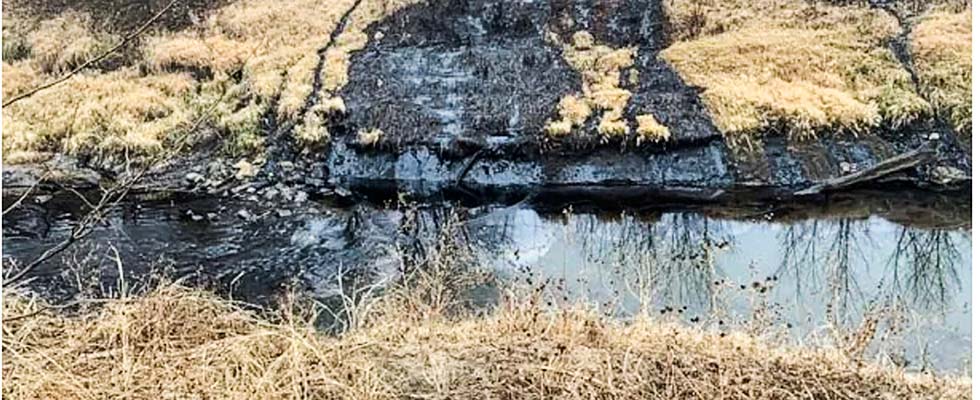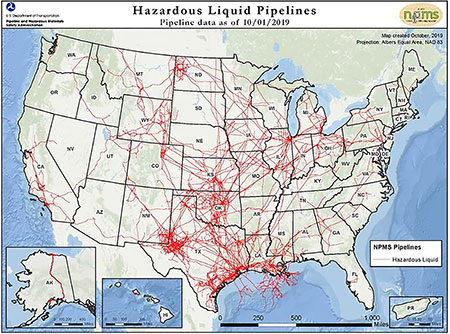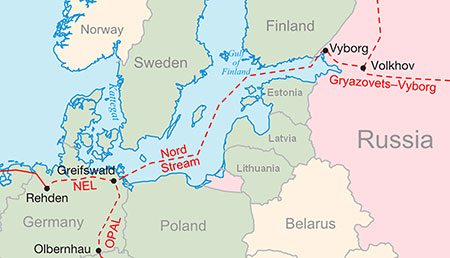
This article focuses on two pipelines and their pumping systems that are, in many ways, polar opposites. One is in Kansas, while the other is in the Baltic states of Europe. One pumps and carries oil from Canada to the southern states of the United States. The other carries natural gas from Russia to Germany. Both pipelines were shut down in 2022. In one, the flow has been restored, but not in the other.

There are political ramifications because the world depends heavily on oil and gas, but the technical aspects are important too.
Keystone Pipeline & Pumps
The Keystone pipeline was built about 20 years ago to transport heavy oil from the tar sands of Alberta south to Cushing, Oklahoma, and then on to Houston. TC Energy (previously TransCanada) is the owner and operator of the pipeline.
There are more than 200,000 miles of pipelines in the U.S. for crude oil and gasoline/diesel and natural gas liquids. This could circle the Earth eight times, but that is peanuts compared to the 2.5 million miles of natural gas pipelines, which could circle the earth 100 times.
Oil pipelines are made of steel or plastic, and most are buried 3 to 6 feet underground, but they are protected by slats of wood, concrete and sand layers.
How is oil pumped through pipelines? Centrifugal pumps are usually placed every 20 to 100 miles to provide the pressure to keep the oil moving, but the distance depends on topography. Electric motors operate the pumps, although diesel motors or gas turbines can be used.
The Keystone pipeline entailed 39 pumping stations. Of these, a Kiewit subsidiary called TIC built 27 stations in two phases. In the first phase, they constructed nine stations with 5,000-horsepower (hp) motors and centrifugal pumps spaced in North and South Dakota. In the second phase, they installed mainline pumps at 16 existing pumping stations from North Dakota to Kansas. They also built from the ground up two stations with 6,500-hp and centrifugal pumps in Kansas and Oklahoma.
Pipeline Leak
The oil flow was stopped on Dec. 7, 2022, just seven minutes after a leak was discovered. The leak spilled 14,000 barrels or nearly 600,000 gallons. The leak was the largest in the U.S. in nearly a decade.
However, this is a minor leak when compared with the 1989 Exxon Valdez spill of 260,000 barrels or the 2010 Deepwater Horizon oil spill of 5,000,000 barrels.
The leak occurred in Washington County, about 200 miles northwest of Kansas City. It is a rural area of over 5,000 people who raise wheat, corn and cattle.

Normally, oil is flowing in the Keystone pipeline at 622,000 barrels per day in a 36-inch pipe that is 2,600 miles long and has been operating since 2010. The Keystone expansion plan, called Keystone XL, was canceled after President Joe Biden denied a key permit needed for the project in 2020. The owner was TC Energy and, as of March 31, 2020, the government of Alberta.
Potential Threats & Damage
The operator of the pipeline soon had more than 100 employees on the ground in conjunction with Environmental Protection Agency (EPA) regulators and other environmental specialists for oversight monitoring. Oil from the leak apparently sprayed upward onto a hillside and flowed downwards into a small creek called Mill Creek. Workers placed booms to contain further oil movement. They also vacuumed oil from the creek into trucks.
The oil from Canada is heavy oil and tends to sink under water, which magnifies the cleanup problem. None of the local population were evacuated, nor had the water supply been threatened in any way.

One observer said the Kansas leak and the two other oil leaks since 2017 vindicated Biden’s decision to cancel Keystone XL in 2020. This is one perspective that focuses on accidents and oil spills. The owner tried for 14 years to get Keystone XL, an extension of the original Keystone pipeline, permitted. While waiting for this to happen, permits were granted in 2017 to increase oil flow rates in Keystone by increasing pressure in the pipeline, a unique situation in U.S. pipelines. Three oil spills occurred in Keystone after this permit was approved, each of several thousand barrels of oil. One is in North Dakota, one in South Dakota and the third—and largest spill—is in Kansas.
There was concern about the downtime because oil transport to Cushing, Oklahoma, which is a multitank hub for U.S. storage and delivery, had been partially interrupted, but downtime did not happen.
Current Pipeline Status
TC Energy stated their commitment to remediate the accident site fully. On Jan. 14, 2023, they announced 12,300 barrels of oil had been recovered. This compares with 14,000 barrels that were leaked from the pipeline, but in many cases, such estimates are understated and often turn out to be twice the original estimate.
A more detailed update by TC Energy was given on Jan. 3, 2023:
“The impacted section of the pipe was completely replaced. It has been transported to a third-party facility where it will be analyzed as part of the investigation. We will share the details of this investigation, once available, as well as our actions.”
All the company will say is the pipeline was operating at reduced pressure when the accident occurred, and that there was no sabotage on the pipeline by a third party. TC Energy reported on Feb. 9, 2023, that the pipeline leak was probably due to bending stress on the pipe and a weld flaw and costs of the incident would be almost $500 million. The Keystone pipeline was returned to service on Dec. 29, 2022, and was fully operational at press time. The company insists the pipeline is operating under reduced pressure.
Nord Stream Pipeline & Pumps
Politically, Germany turned its back on coal and nuclear in the period of 2005 to 2015. This left it with solar and wind renewables and of course natural gas, which came from Russia, which had plenty of it. This cozy relationship between Germany and Russia continued until the eventual building of a second Baltic pipeline, Nord Stream 2, which was completed in September 2021, but the gas never came because of the buildup of Russian forces around Ukraine. In October 2012 at Portovaya Bay, on the Baltic Coast of Russia, a ceremony announced the opening of Nord Stream 1, actually a twin pipeline from Russia to Germany that is 621 miles long.
Gerard Schroder was chairman of the shareholders’ pipeline committee (and former chancellor of Germany). Vladimir Putin was president of Russia. Putin said:
“Nord Stream will meet Europe’s growing demand for energy resources. Gas will be supplied directly by the shortest route, linking the major Russian gas reserves to European markets without transit risks, steadily and smoothly. We can guarantee this.”1
Eight gas-pumping units, or compressors, are located at Gazprom’s gas transmission facility at Portovaya Bay. Each is powered by a Rolls-Royce motor. These units bring the natural gas up to the pressure required to push the gas along the pipelines without the need for pressurization stations along the pipeline.
Six of the pumping units have a 52-megawatt (MW) capacity while the remaining two are 27-MW. Gazprom said at the time this was the most powerful gas compressor station in the world.
Before the gas hits the Nord Stream pipelines, solid particles are removed, water is stripped out and gas volumes are measured at the compressor station.
Russian Rationale
Both oil and gas exported from Russia bring in revenue that can be used to support the Russian war in Ukraine, but the export revenue from oil sales is greater than export revenue from gas sales.
Russia has realized that cutting natural gas does not affect their export revenue
(like oil does), but it does affect the economies of European Union (EU) countries more. For Russia, cutting gas is a powerful economic weapon. Russia supplied the EU with 40% of its gas in 2021, with Germany, Italy and the Netherlands being the top three importers. Germany had imported more than 50% of its gas from Russia via the Nord Stream 1 pipeline.
By the end of June 2022, this had fallen to 25%. The harm to the EU was greater because the price of natural gas in Europe and Asia rose in October 2021 to five times its value of a year before. It became more expensive to replace Russian gas.
Pipeline Shutoff
In July 2022, Russia cut back its main supply of gas to Europe via the Nord Stream 1 pipeline to only about 20% of its capacity. The U.K. was less affected, as they imported less than 5% from Russia. Russia blamed the cutback on a faulty pumping turbine, but Germany dismissed this. Russia shut down Nord Stream 1 in August 2022. Since then, Russia says it has been reviewing the Nord Stream 1 and Nord Stream 2 pipelines, examining all infrastructure.
Explosions blew up the Nord Stream pipelines in September 2022, when neither pipeline was flowing gas. Experts from Sweden said it was sabotage but did not lay the blame on anyone. In the 10-month period ending November 2022, the costs Germany paid to import gas, including liquefied natural gas (LNG), more than doubled compared to the previous period. Worse, the amount of gas imported fell almost 30%.
Energy Security
Gas supplies from Russia have been cut off and prices have risen, marked by intermittent surges. Europe has a gas crisis, and one clear lesson is countries need to preserve their energy security.
Europe has scrambled to replace Russian gas by importing LNG. In late January 2023, the first LNG import was tankered into a new LNG terminal that took Germany eight months to build. Winter in Europe without enough gas or electricity can be hard to take, as the suffering population in Ukraine is telling us.
Germany had imported more than 50% of its gas from Russia via the Nord Stream 1 pipeline. By the end of June 2022, this had fallen to 25%, and recently Russia stopped the flow completely.
Putin in early September proclaimed that Europe’s energy problems are a result of the sanctions imposed by the West on Russia. It is easier to blame the West than admit that the start of this energy war was Russia’s invasion of Ukraine.
In Europe, energy security has taken precedence over climate security. When the lights go out and the home heaters will not work, the risks of climate disasters fade.Both of these pipelines, on opposite sides of the world, have something in common: energy security. The need and scale of supply are much greater in Nord Stream pipelines than in the Keystone pipeline.
Energy security is still a concern within the U.S. Recall the polar ice storm that barreled down through Oklahoma and into Texas in February 2021 and caused massive electrical blackouts that almost collapsed the electrical grid.
The world will need oil and gas for a long time. Previous estimates of 36% to 46% of global energy were predicted by credible companies like BP and DNV. EIA currently predicts 50% of oil and gas.
References
Nord Stream Facts, Issue 24, 2012.
Facts taken from onesteppower.com, forbes.com, bbc.com, tpenergy.com, oilprice.com, reuters.com

